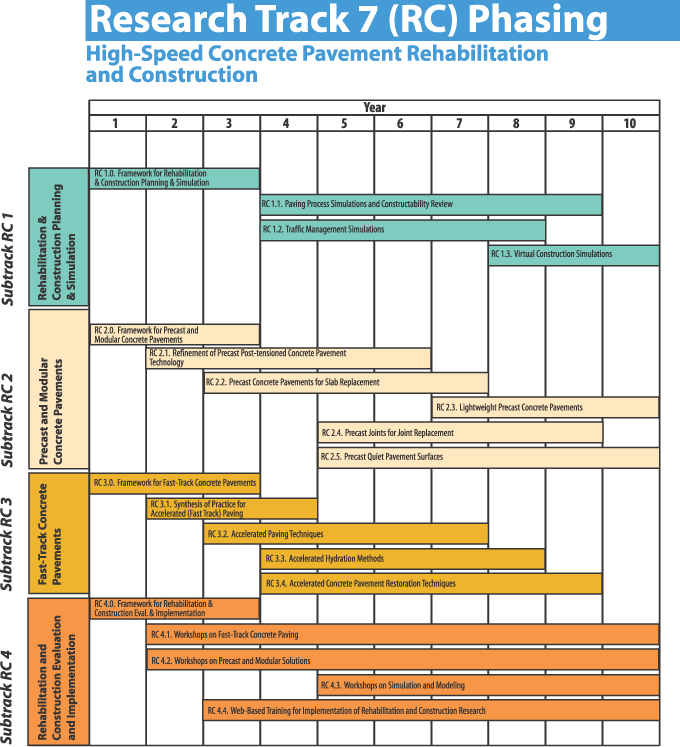U.S. Department of Transportation
Federal Highway Administration
1200 New Jersey Avenue, SE
Washington, DC 20590
202-366-4000
Federal Highway Administration Research and Technology
Coordinating, Developing, and Delivering Highway Transportation Innovations
 |
| This report is an archived publication and may contain dated technical, contact, and link information |
|
Publication Number: FHWA-HRT-05-053 Date: September 2005 |

Figure 7. Bar Chart. Track 7 (RC) subtrack and problem statement phasing chart.
Track 7 (RC) subtrack and problem statement phasing chart.The horizontal bar chart in this figure shows the approximate time phasing of the problem statements in track 7, High-Speed Concrete Pavement Rehabilitation and Construction (RC), grouped by subtrack across 10 years. There are four subtracks in track 7: (1) Rehabilitation and Construction Planning and Simulation; (2) Precast and Modular Concrete Pavements; (3) Fast-Track Concrete Pavements; and (4) Rehabilitation and Construction Evaluation and Implementation
In subtrack 1 the problem statements are arranged as follows: Problem Statement RC 1.0. Framework for Rehabilitation and Construction Planning and Simulation extends from years 1 to 3; Problem Statement RC 1.1. Paving Process Simulations and Constructability Review extends from years 4 to 9; Problem Statement RC 1.2. Traffic Management Simulations extends from years 4 to 8; and Problem Statement RC 1.3. Virtual Construction Simulations extends from years 8 to 10.
In subtrack 2 the problem statements are arranged as follows: Problem Statement RC 2.0. Framework for Precast and Modular Concrete Pavements extends from years 1 to 3; Problem Statement RC 2.1. Refinement of Precast, Posttensioned Concrete Pavement Technology extends from years 2 to 6; Problem Statement RC 2.2. Precast Concrete Pavements for Slab Replacement extends from years 3 to 7; Problem Statement RC 2.3. Lightweight Precast Concrete Pavements extends from years 7 to 10; Problem Statement RC 2.4. Precast Joints for Joint Replacement extends from years 5 to 9; and Problem Statement RC 2.5. Precast Quiet Pavement Surfaces extends from years 5 to 10.
In subtrack 3 the problem statements are arranged as follows: Problem Statement RC 3.0. Framework for Fast-Track Concrete Pavements extends from years 1 to 3; Problem Statement RC 3.1. Synthesis of Practice for Accelerated (Fast-Track) Paving extends from years 2 to 4; Problem Statement RC 3.2. Accelerated Paving Techniques extends from years 3 to 7; Problem Statement RC 3.3. Accelerated Hydration Methods extends from years 4 to 8; and Problem Statement RC 3.4. Accelerated Concrete Pavement Restoration Techniques extends from years 4 to 9.
In subtrack 4 the problem statements are arranged as follows: Problem Statement RC 4.0. Framework for Rehabilitation and Construction Evaluation and Implementation extends from years 1 to 3; Problem Statement RC 4.1. Workshops on Fast-Track Concrete Paving extends from years 2 to 10; Problem Statement RC 4.2. Workshops on Precast and Modular Concrete Pavement Solutions extends from years 2 to 10; Problem Statement RC 4.3. Workshops on Rehabilitation and Construction Simulation and Modeling extends from years 5 to 10; and Problem Statement RC 4.4. Web-Based Training for Implementation of Rehabilitation and Construction Research extends from years 3 to 10.